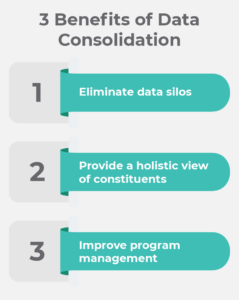Nonprofits, large and small, collect and analyze data from various sources. Donor data, such as contact information and past giving behavior, enhances donor management and allows organizations to appeal to supporters’ unique reasons for giving. On the other hand, financial data keeps nonprofits organized and aware of the health of their operations.
By properly collecting and analyzing data, these insights can be used to forecast donor behavior and even project fundraising revenue. Data consolidation provides a strong foundation for this by ensuring all nonprofit data is accurate, up-to-date, and integrated on a single platform.
In this guide, we’ll discuss strategies nonprofits can employ to achieve this. Let’s begin by exploring the benefits of consolidating data.
Why consolidate your nonprofit’s data?
You may struggle with scattered and unorganized data if your nonprofit uses many different tools and systems. For example, your website, marketing tools, and fundraising software collect and store useful information. Without compiling this information in one location, it will be challenging to understand your donors and operations comprehensively.
Data consolidation will help you overcome these challenges, yielding benefits like:

- The elimination of data silos. Data silos occur when data is stored across multiple systems, requiring staff to move information from one system to another manually. However, by using a tool like Salesforce Nonprofit Cloud, nonprofits can integrate each system with their CRM to automatically flow data into one unified platform. This integrated system enhances staff productivity and efficiency by removing the need to transfer data between systems.
- A holistic view of constituents. Once all data is compiled in one location, nonprofits gain a comprehensive view of donors, volunteers, and program participants. This deeper understanding of constituents means nonprofits can target the right audiences, create personalized experiences, and engage supporters better. These improvements, combined with tailored donor stewardship tactics, boost retention.
- Improved program management. Consolidating program data allows staff to easily track each case, monitor individual participant’s progress, and gauge the program’s overall health, allowing nonprofits to identify opportunities to improve the program quickly.
These benefits empower nonprofits to implement cost-saving and revenue-generating improvements, like boosting staff efficiency and donor retention.
What are some data consolidation strategies?
Data consolidation can be complex depending on your nonprofit’s size and the number of systems it uses. It’s best to work with a professional technology consultant for complicated cases to ensure the process runs smoothly.
Whether your organization completes the project on its own or leverages the help of a professional, consider implementing these strategies:
1. Integrate data from various sources.
Each system holds valuable insights into donors’ giving habits and preferences, so it’s essential to integrate each tool you use with your CRM.
To get started, audit each tool you use and research integration methods. For example, many options are available for integrating your website, depending on what CMS and CRM your nonprofit uses. Fíonta’s guide to Salesforce website integration recommends tools for WordPress users (e.g., Web to Lead Forms or the WordPress Object Sync plugin), Drupal’s Salesforce Suite, Baja, the Salesforce API, and Mulesoft.
In addition to your website, here are some commonly used tools your nonprofit should integrate with its CRM:
- Email marketing platforms
- Marketing analytics tools, such as Google Analytics
- Payment processing and financial management systems
- Survey and feedback tools
- Mobile apps
Most integrations can be completed using middleware platforms, connectors or plugins, and APIs. If your nonprofit has highly specific or complicated needs, such as using many systems, consider working with software developers to create custom integrations.
2. Prioritize data hygiene.
As NPOInfo explains, proper donor data management is characterized by maintaining data over time to ensure that it is accurate and well-organized. Typically, this is accomplished by regularly checking data and making corrections as needed.
While data consolidation reduces human errors during manual data transfers, some data hygiene issues can still arise when data from various channels and sources is combined. When auditing data, consider potential problems such as:
- Duplicate data. Data from different sources may contain multiple records for the same donor. These duplicate records can lead to inaccurate findings and slow down data analysis. Merge any duplicate entries to maintain a clean database.
- Inconsistent formatting. Variations in data formatting can make it difficult to sort and analyze data. For example, inconsistent date formats could make it impossible to determine total revenue during a given period accurately. Outline standardized data entry policies, share them with staff, and frequently audit data for errors.
- Incomplete or inaccurate data. Merging data from disparate sources could result in missing fields or inaccuracies, negatively impacting your ability to contact donors and beneficiaries.
When checking your data, confirm that data security safeguards are functioning properly to protect donors’ privacy. These safeguards are particularly important for organizations operating within the healthcare industry. Additionally, back up data and test these secondary files to prevent data loss.
3. Plan for significant investments of time and resources.
As mentioned, integrating your nonprofit’s systems with your CRM can be a time-intensive process that may require help from a team of experts. To prepare for the process, carefully plan and allocate resources such as:
- Financial resources to cover consultant fees, software and integration tool costs, ongoing maintenance, and developer costs.
- Staff time required to oversee the project, complete training, maintain data standards, and provide IT support.
- Technology and infrastructure needed to support consolidation efforts, such as hardware, servers, and integration tools.
A consultant can help you plan for your upcoming data consolidation. Because factors like the length of the process, necessary tools, and the cost of the project can vary, you’ll need to meet with the consultant beforehand to produce an accurate estimate.
Data analysis allows nonprofits to unlock valuable insights about their constituents, enabling them to attract and retain more loyal supporters. However, these insights are far more useful when they give a complete view of the organization’s operations, which is made possible by data consolidation.
